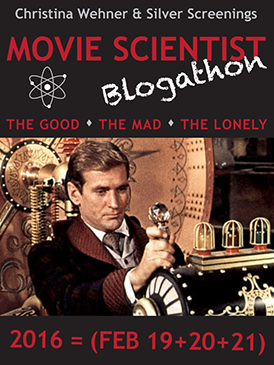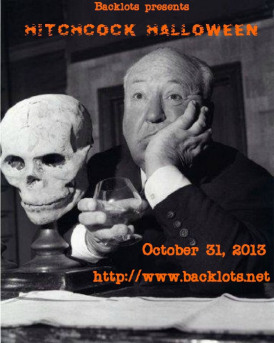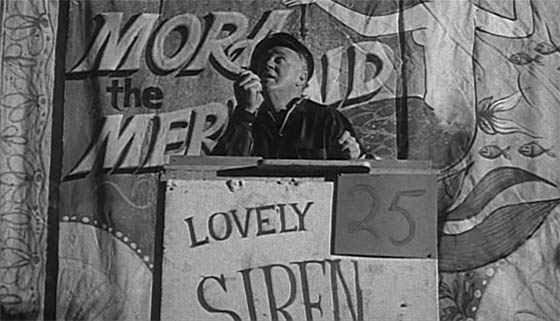 Curtis Harrington’s Night Tide (1961) suggests what might have happened had Jean Cocteau been hired to direct an episode of The Twilight Zone. Perhaps it lacks Cocteau’s style of experimentation, but there is a romantic and eerie quality to this low-budget labor of love which places it in the same universe as Orpheus (1950), another black-and-white fantasy with one foot in the drubby everyday. Harrington had a spotty career, and never quite achieved the breakthrough he deserved; but Night Tide makes his talent obvious. An early effort, it gives the impression that it was shot on the fly and scraped together on pennies, but every shot is gorgeously composed; when assembling stills for this little review I quickly grabbed so many that I realized it would take a novel to use all of them. It’s clear to me now that Night Tide could have been a silent film, so pure and direct and poetic is the cinematic storytelling on display.
Curtis Harrington’s Night Tide (1961) suggests what might have happened had Jean Cocteau been hired to direct an episode of The Twilight Zone. Perhaps it lacks Cocteau’s style of experimentation, but there is a romantic and eerie quality to this low-budget labor of love which places it in the same universe as Orpheus (1950), another black-and-white fantasy with one foot in the drubby everyday. Harrington had a spotty career, and never quite achieved the breakthrough he deserved; but Night Tide makes his talent obvious. An early effort, it gives the impression that it was shot on the fly and scraped together on pennies, but every shot is gorgeously composed; when assembling stills for this little review I quickly grabbed so many that I realized it would take a novel to use all of them. It’s clear to me now that Night Tide could have been a silent film, so pure and direct and poetic is the cinematic storytelling on display.
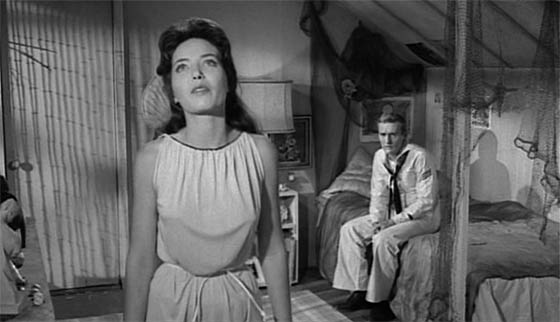 It’s just the story of a sailor and a mermaid, simply, but Harrington takes the familiar fairy tale premise and transposes it onto a mostly-deserted California boardwalk carnival, with ferris wheels and tilt-a-whirls, carnival barkers and sideshows. Into this world walks Johnny (a young Dennis Hopper), making the most of his shore leave by attending a jazz club. Within seconds he has become fixated upon a beautiful brunette named Mora (Linda Lawson), and with a sense of purpose fueled by his own desperate deadline – he won’t be ashore forever – Johnny pursues the girl out of the club, even after she’s casually stuck him with the bill. She shows little interest in Johnny, but with determination he manages to get her name (just before the world’s most awkward lunge for a kiss). Her distraction seems to be the presence of a mysterious woman who lurks in the shadows, watching her, in covert pursuit, but Johnny barely glimpses the stranger. In the morning she’s in better spirits, and all those efforts to win her affections seem to be paying off – perhaps too quickly.
It’s just the story of a sailor and a mermaid, simply, but Harrington takes the familiar fairy tale premise and transposes it onto a mostly-deserted California boardwalk carnival, with ferris wheels and tilt-a-whirls, carnival barkers and sideshows. Into this world walks Johnny (a young Dennis Hopper), making the most of his shore leave by attending a jazz club. Within seconds he has become fixated upon a beautiful brunette named Mora (Linda Lawson), and with a sense of purpose fueled by his own desperate deadline – he won’t be ashore forever – Johnny pursues the girl out of the club, even after she’s casually stuck him with the bill. She shows little interest in Johnny, but with determination he manages to get her name (just before the world’s most awkward lunge for a kiss). Her distraction seems to be the presence of a mysterious woman who lurks in the shadows, watching her, in covert pursuit, but Johnny barely glimpses the stranger. In the morning she’s in better spirits, and all those efforts to win her affections seem to be paying off – perhaps too quickly.
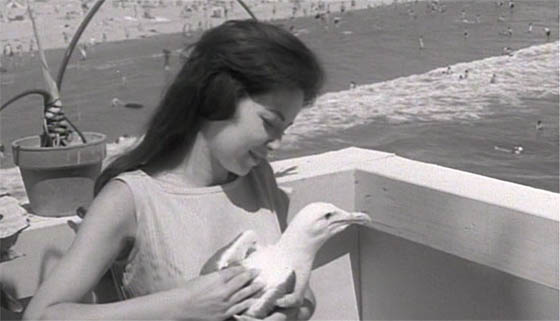 There’s something a little off about Mora. She lives above a carousel, and takes comfort in its intermittent calliope music. While they’re eating seafood upon the balcony of her apartment, she seems to beckon, and easily catches in her arms, a passing seagull, stroking its neck lovingly. She tells him that she’s a mermaid down at the carnival. People pay to have a glimpse of her as she sits in a submerged tank, combing her hair. It’s all fake, she tells him; she wears a phony tail over her legs. The man who runs the show, Captain Murdock (Gavin Muir), claims he found her on a Greek island, and promises to tell Johnny more should he ever drop by his home. Johnny is entranced by all this, with nervous laughter and a wide grin. Watching Dennis Hopper play an innocent, for once, is fascinating: all queasy energy and desperation. His Method approach adds constantly shifting colors to what could otherwise be the simple, and bland, wide-eyed fellow who often fronts these kinds of fables.
There’s something a little off about Mora. She lives above a carousel, and takes comfort in its intermittent calliope music. While they’re eating seafood upon the balcony of her apartment, she seems to beckon, and easily catches in her arms, a passing seagull, stroking its neck lovingly. She tells him that she’s a mermaid down at the carnival. People pay to have a glimpse of her as she sits in a submerged tank, combing her hair. It’s all fake, she tells him; she wears a phony tail over her legs. The man who runs the show, Captain Murdock (Gavin Muir), claims he found her on a Greek island, and promises to tell Johnny more should he ever drop by his home. Johnny is entranced by all this, with nervous laughter and a wide grin. Watching Dennis Hopper play an innocent, for once, is fascinating: all queasy energy and desperation. His Method approach adds constantly shifting colors to what could otherwise be the simple, and bland, wide-eyed fellow who often fronts these kinds of fables.
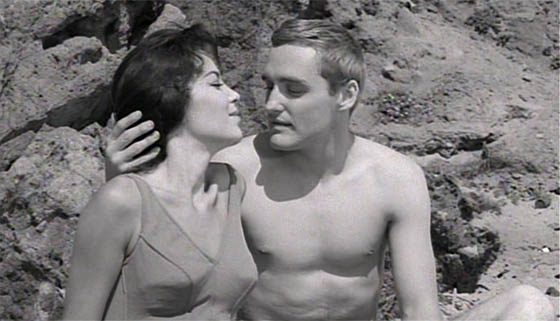
At first, things are going far too well for Johnny. They make out on the beach: happy young lovers. She welcomes him into all facets of her life, including a strangely ritualistic dance to bongos with some beachniks. She also tells him that yes, the captain did rescue her from an island, and he’s like a father to her. But something else is going on; that mysterious woman keeps following Mora, and then Johnny – and Mora seems to be frightened of some looming fate that she refuses to voice. When he finally does pay a visit to Captain Murdock, the man asks Johnny if he’s ever heard of the Greek myth of the Sirens, who would lure sailors to their deaths. When Murdock tells Johnny straight out that yes, Mora really is a mermaid, and to beware the full moon and the night’s high tide, Johnny scoffs; but soon he’s learning that the police have been questioning her. Two of her ex-boyfriends were found dead.
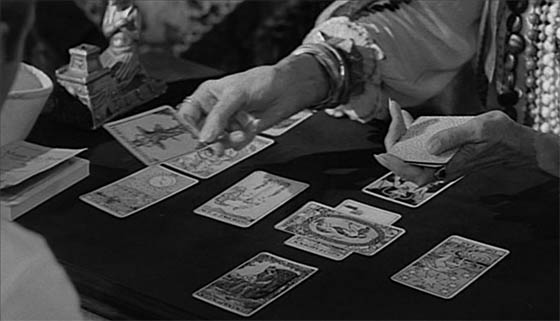 The carnival’s clairvoyant, Madame Romanovitch (Marjorie Eaton), reads his Tarot and seems something ominous in his future. Incidentally, this might be a cinematic first in that the film actually stops and explains, accurately, what the Tarot is and how it works. If the film had been a bigger hit, audiences might have gone flocking to their local occult resalers to get a deck of their own.
The carnival’s clairvoyant, Madame Romanovitch (Marjorie Eaton), reads his Tarot and seems something ominous in his future. Incidentally, this might be a cinematic first in that the film actually stops and explains, accurately, what the Tarot is and how it works. If the film had been a bigger hit, audiences might have gone flocking to their local occult resalers to get a deck of their own.
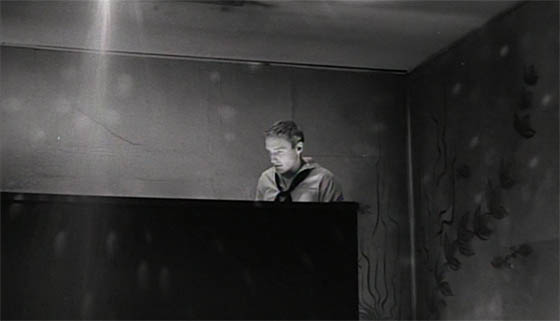 By this point in the film, the audience is convinced they know what’s happening. They don’t. The fact that the twists are not just unpredictable but believable – and, surprisingly, emotionally raw – is Night Tide‘s ace in the hole. The narrative has the feel of a classic short story, one that Melville or Poe might have written; so no wonder that it ends on a quotation by Poe (Roger Corman’s Vincent Price-starring adaptations were a hit at the time). The screenplay, by Harrington, was actually based on his own short story. But the tone could have gone a variety of ways, depending on who was directing and who was cast; it shares something with film noir, for example; particularly the great Nightmare Alley (1947), which is also set in the world of carnival sideshows. The eerie, muted, haunted quality of the vacant boardwalks and unoccupied carousel brings to mind Carnival of Souls (1962), and there are touches of the horror film, particularly in Johnny’s increasingly paranoid fantasies as he begins to question Mora’s nature. There’s a wonderful moment, which recalls Roman Polanski’s style, when Dennis Hopper, having just dreamed of Mora as a mermaid, awakens and finds himself tracking her wet footprints out of the bathtub and down the hallway. With him, we study them closely to ensure they remain human with every print.
By this point in the film, the audience is convinced they know what’s happening. They don’t. The fact that the twists are not just unpredictable but believable – and, surprisingly, emotionally raw – is Night Tide‘s ace in the hole. The narrative has the feel of a classic short story, one that Melville or Poe might have written; so no wonder that it ends on a quotation by Poe (Roger Corman’s Vincent Price-starring adaptations were a hit at the time). The screenplay, by Harrington, was actually based on his own short story. But the tone could have gone a variety of ways, depending on who was directing and who was cast; it shares something with film noir, for example; particularly the great Nightmare Alley (1947), which is also set in the world of carnival sideshows. The eerie, muted, haunted quality of the vacant boardwalks and unoccupied carousel brings to mind Carnival of Souls (1962), and there are touches of the horror film, particularly in Johnny’s increasingly paranoid fantasies as he begins to question Mora’s nature. There’s a wonderful moment, which recalls Roman Polanski’s style, when Dennis Hopper, having just dreamed of Mora as a mermaid, awakens and finds himself tracking her wet footprints out of the bathtub and down the hallway. With him, we study them closely to ensure they remain human with every print.
 Harrington doesn’t settle on a genre, but pitches his tone toward something lyrical and sad; even the early, happy moments have a peculiar weight of tragedy to them, as though we’re seeing events long after they’ve occurred, and we know something unfortunate awaits these characters. So the film’s shift into suspense mode, accompanied by some hallucinogenic passages, is not jarring, but has the feeling of the inevitable. The spare cast is effectively used, and there’s also a nice turn by Luana Anders as Ellen, the lovelorn daughter of the carousel operator, who patiently waits for Hopper to notice how much she cares for him, as he stumbles down his own dark alleys; note the moment at a police station, where, just as Hopper leaves, Harrington turns his camera about to take notice of Anders leaning out the door, looking after him as he goes, betraying a girlish excitement she otherwise keeps carefully guarded. Observe, too, how Linda Lawson’s Mora seems otherworldly in most every shot. In one scene, in which she walks slowly down a hallway, clad only in a towel, Harrington lets the walls and ceiling capture the flickering, aquatic light that’s cast, presumably, from the bathtub in the next room, making it appear that she’s submerged. Later she lies upon her side in bed, watching Hopper, and the fishing net hanging from the wall behind her makes her look like she’s been snagged and dragged up and out of the depths. When she’s lured by the “night tide,” and stands under a pier looking up at the moon, the wooden post is at her back, so she might be either a siren perched upon the rocks or a ship’s figurehead. As for Hopper, he proves late in the film that he’s not afraid of displaying naked emotion, even exposing his character’s flaws: his immaturity and borderline cowardice. It’s a reminder of how risky and powerful an actor Dennis Hopper could be.
Harrington doesn’t settle on a genre, but pitches his tone toward something lyrical and sad; even the early, happy moments have a peculiar weight of tragedy to them, as though we’re seeing events long after they’ve occurred, and we know something unfortunate awaits these characters. So the film’s shift into suspense mode, accompanied by some hallucinogenic passages, is not jarring, but has the feeling of the inevitable. The spare cast is effectively used, and there’s also a nice turn by Luana Anders as Ellen, the lovelorn daughter of the carousel operator, who patiently waits for Hopper to notice how much she cares for him, as he stumbles down his own dark alleys; note the moment at a police station, where, just as Hopper leaves, Harrington turns his camera about to take notice of Anders leaning out the door, looking after him as he goes, betraying a girlish excitement she otherwise keeps carefully guarded. Observe, too, how Linda Lawson’s Mora seems otherworldly in most every shot. In one scene, in which she walks slowly down a hallway, clad only in a towel, Harrington lets the walls and ceiling capture the flickering, aquatic light that’s cast, presumably, from the bathtub in the next room, making it appear that she’s submerged. Later she lies upon her side in bed, watching Hopper, and the fishing net hanging from the wall behind her makes her look like she’s been snagged and dragged up and out of the depths. When she’s lured by the “night tide,” and stands under a pier looking up at the moon, the wooden post is at her back, so she might be either a siren perched upon the rocks or a ship’s figurehead. As for Hopper, he proves late in the film that he’s not afraid of displaying naked emotion, even exposing his character’s flaws: his immaturity and borderline cowardice. It’s a reminder of how risky and powerful an actor Dennis Hopper could be.
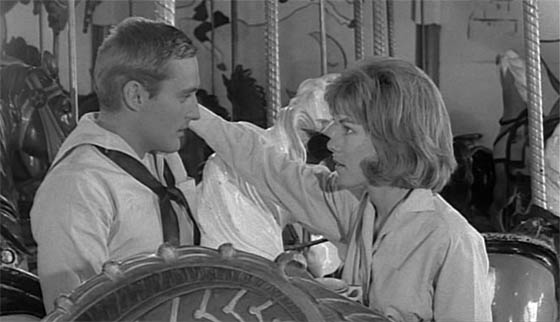 And all for this “minor” film, a B-picture too understated and sophisticated for most of its peers. But it’s hypnotic, too – and lit with a bit of the full moon’s magic.
And all for this “minor” film, a B-picture too understated and sophisticated for most of its peers. But it’s hypnotic, too – and lit with a bit of the full moon’s magic.
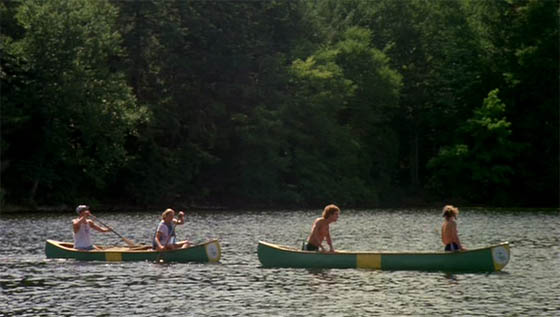 As a child, my summer camp experiences were pretty limited. My parents used to take me to a place called “Family Camp,” a Christian-themed, family-and-kids get-together amidst the towering redwood trees of northern California; but I was never long separated from my parents. In elementary school, a two-day field trip to the Wisconsin northwoods finally had me bunking with my fellow classmates, suffering through dull arts-and-crafts sessions, canoeing, and singing and telling stories while roasting marshmallows around a campfire. That was only for one or two nights, though. I’m left to the movies to have the summer camp experience properly explained to me. So this brings us to today’s double feature, a full immersion into summer camp of the late 70’s and early 80’s, to see just what experiences I missed as a youth. And it’s clearer to me now. I missed out.
As a child, my summer camp experiences were pretty limited. My parents used to take me to a place called “Family Camp,” a Christian-themed, family-and-kids get-together amidst the towering redwood trees of northern California; but I was never long separated from my parents. In elementary school, a two-day field trip to the Wisconsin northwoods finally had me bunking with my fellow classmates, suffering through dull arts-and-crafts sessions, canoeing, and singing and telling stories while roasting marshmallows around a campfire. That was only for one or two nights, though. I’m left to the movies to have the summer camp experience properly explained to me. So this brings us to today’s double feature, a full immersion into summer camp of the late 70’s and early 80’s, to see just what experiences I missed as a youth. And it’s clearer to me now. I missed out.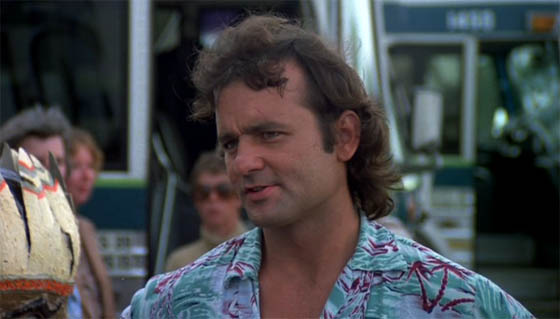 I also missed out on Meatballs (1979), which I’d never seen prior to now. I’m not exactly sure how I avoided it, since as a kid of the Ghostbusters era I was naturally a Bill Murray fan, but I can tell you that the only films in this franchise I viewed as an adolescent were the third (horrible) and fourth (Corey Feldman), so I never really associated the series with good things. Today you have to watch this film with nostalgia, I’m afraid, or you won’t get much out of it at all. Murray, fresh off Saturday Night Live, chews the scenery mercilessly, rarely sticks to the script, and basically becomes a movie star, immediately, but in the most undignified way possible. It was a time when irreverence was enough. Much of what Murray says (or improvises) is funny, but a surprising amount settles for smug rather than clever. To be fair, he has little to go on here. Director Ivan Reitman (Ghostbusters) is creating a genre, the Summer Camp Movie, with an ensemble cast of mostly unfamiliar faces, and a “plot” which is really just a collection of gags on the way to a rote climax (a competition between two rival summer camps, i.e. the slobs vs. the snobs). Though PG-rated, it owes much to Animal House (1978), which was co-written by Harold Ramis. Ramis went on to direct a further variation on the formula with Caddyshack (1980); both are better, funnier films than Meatballs. It’s fair to say that Murray owns this film, though he casts such a large shadow that I’d be curious to see what the film would look like without him.
I also missed out on Meatballs (1979), which I’d never seen prior to now. I’m not exactly sure how I avoided it, since as a kid of the Ghostbusters era I was naturally a Bill Murray fan, but I can tell you that the only films in this franchise I viewed as an adolescent were the third (horrible) and fourth (Corey Feldman), so I never really associated the series with good things. Today you have to watch this film with nostalgia, I’m afraid, or you won’t get much out of it at all. Murray, fresh off Saturday Night Live, chews the scenery mercilessly, rarely sticks to the script, and basically becomes a movie star, immediately, but in the most undignified way possible. It was a time when irreverence was enough. Much of what Murray says (or improvises) is funny, but a surprising amount settles for smug rather than clever. To be fair, he has little to go on here. Director Ivan Reitman (Ghostbusters) is creating a genre, the Summer Camp Movie, with an ensemble cast of mostly unfamiliar faces, and a “plot” which is really just a collection of gags on the way to a rote climax (a competition between two rival summer camps, i.e. the slobs vs. the snobs). Though PG-rated, it owes much to Animal House (1978), which was co-written by Harold Ramis. Ramis went on to direct a further variation on the formula with Caddyshack (1980); both are better, funnier films than Meatballs. It’s fair to say that Murray owns this film, though he casts such a large shadow that I’d be curious to see what the film would look like without him.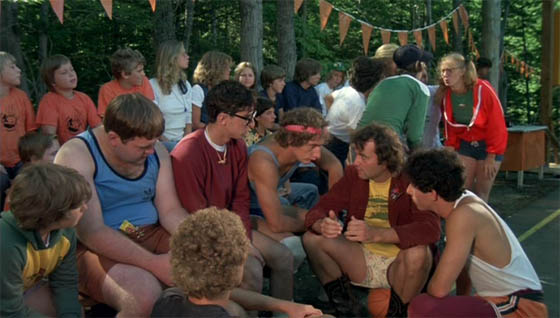 That doesn’t mean I’m anxious to watch Meatballs Part II. What it does mean is that Reitman takes an interesting approach to the film, which is to fill the cast with appealingly fresh-faced kids and teenagers, not just twenty-somethings trying to pass as kids. The extras in the background of every scene are clearly real kids having fun, giving the feel of summer camp, and a warmth, that is much more endearing than Elmer Bernstein’s cloying score (and I say this as a fan of Bernstein’s, in particular his work on the Reitman-produced Heavy Metal). As for the cast’s principals: they shine, and come off as exact characters, many of them accomplishing this without exposition explaining who they are or what has brought them here. Notice, for example, how blonde teen A.L. (Kristine DeBell), though she has just a hint of a romantic subplot, finds something to do in every scene without the film having to bend over backward to give us a fully-developed “arc.” She’s really just a believable, semi-popular, slightly tomboyish teenage girl who is neither heroic nor vilified – just getting by and having fun. I believed her, as I did most of the rest of the campers. That is nice to see. (I feel obligated to mention that the innocent-looking DeBell was in the X-rated musical of Alice in Wonderland [1976]. I appreciate that she got cast in Meatballs anyway.)
That doesn’t mean I’m anxious to watch Meatballs Part II. What it does mean is that Reitman takes an interesting approach to the film, which is to fill the cast with appealingly fresh-faced kids and teenagers, not just twenty-somethings trying to pass as kids. The extras in the background of every scene are clearly real kids having fun, giving the feel of summer camp, and a warmth, that is much more endearing than Elmer Bernstein’s cloying score (and I say this as a fan of Bernstein’s, in particular his work on the Reitman-produced Heavy Metal). As for the cast’s principals: they shine, and come off as exact characters, many of them accomplishing this without exposition explaining who they are or what has brought them here. Notice, for example, how blonde teen A.L. (Kristine DeBell), though she has just a hint of a romantic subplot, finds something to do in every scene without the film having to bend over backward to give us a fully-developed “arc.” She’s really just a believable, semi-popular, slightly tomboyish teenage girl who is neither heroic nor vilified – just getting by and having fun. I believed her, as I did most of the rest of the campers. That is nice to see. (I feel obligated to mention that the innocent-looking DeBell was in the X-rated musical of Alice in Wonderland [1976]. I appreciate that she got cast in Meatballs anyway.) I always have a bit of difficulty trying to express this criticism of Pixar, but as great as their films often are, I always get the feeling that there have been a few too many story meetings – that every corner has been scrubbed clean to serve the express, focused purpose of the story and themes. Life is not so neatly arranged. Everyone is participating in their own story, of course, but we cross paths with one another at different points in our own individual character arcs. One person’s catharsis might occur when another is just in the opening passages of his own personal narrative. Our plotlines don’t all tie up neatly and at the same moment. Okay, so Reitman can’t resist serving up a couple of character arcs that do tie up pretty neatly by the end of summer camp, and this is exactly what gives Wet Hot American Summer (2001) so much to parody. There is a character called Spaz (Jack Blum). He has thick white tape on his glasses. At a certain point, he finds romance (kinda). There’s a gag that his father has tape on his glasses too. Yes, the film does this, and you can cringe.
I always have a bit of difficulty trying to express this criticism of Pixar, but as great as their films often are, I always get the feeling that there have been a few too many story meetings – that every corner has been scrubbed clean to serve the express, focused purpose of the story and themes. Life is not so neatly arranged. Everyone is participating in their own story, of course, but we cross paths with one another at different points in our own individual character arcs. One person’s catharsis might occur when another is just in the opening passages of his own personal narrative. Our plotlines don’t all tie up neatly and at the same moment. Okay, so Reitman can’t resist serving up a couple of character arcs that do tie up pretty neatly by the end of summer camp, and this is exactly what gives Wet Hot American Summer (2001) so much to parody. There is a character called Spaz (Jack Blum). He has thick white tape on his glasses. At a certain point, he finds romance (kinda). There’s a gag that his father has tape on his glasses too. Yes, the film does this, and you can cringe.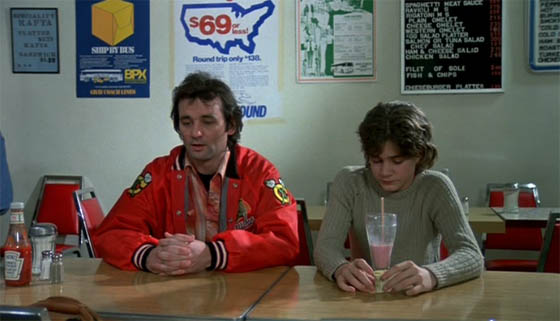 But I cringed a lot more at the tale of Rudy (Chris Makepeace), the social outcast whom Murray’s Tripper takes under his wing, to teach him important life lessons. It’s Rudy who wins the big race at the end, as the inspiring music rises. It’s Rudy who has big puppy dog eyes that look with almost absurd admiration at Tripper. And he will look at you, and he will look into your soul too, and you will weep for your pet rabbit who died when you were only five years old, and if only you could recapture the innocence of those days again. Rudy ostensibly helpes Tripper with his life, as well, by trying to get him to admit that he actually cares for fellow camp counsellor Roxanne (Kate Lynch). But we know that Tripper and Roxanne would end up together with or without this little moppet delivering lines like, “You really like Roxanne, don’t you?”
But I cringed a lot more at the tale of Rudy (Chris Makepeace), the social outcast whom Murray’s Tripper takes under his wing, to teach him important life lessons. It’s Rudy who wins the big race at the end, as the inspiring music rises. It’s Rudy who has big puppy dog eyes that look with almost absurd admiration at Tripper. And he will look at you, and he will look into your soul too, and you will weep for your pet rabbit who died when you were only five years old, and if only you could recapture the innocence of those days again. Rudy ostensibly helpes Tripper with his life, as well, by trying to get him to admit that he actually cares for fellow camp counsellor Roxanne (Kate Lynch). But we know that Tripper and Roxanne would end up together with or without this little moppet delivering lines like, “You really like Roxanne, don’t you?”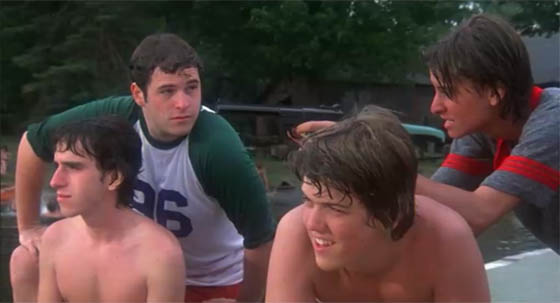 This big brother relationship, of camp counsellor nurturing the social misfit, recurs in The Burning (1981), but, I’d argue, it’s to more satisfying ends. Alfred (Brian Backer) can’t help spying on the girl of his dreams, Sally (Carrick Glenn); when he causes a furor by sneaking into the girl’s showers to get a better look, Counsellor Todd (Brian Matthews) takes him on as his personal responsibility, only without using nonstop improvisational comedy as a tool. No, the wisecracks here are delivered by class clown Dave, played by a pre-Seinfeld Jason Alexander. As class clowns typically will, Dave offers détente amongst the various cliques, and is friend to nerd and jock alike (to the former, by providing Playboys and Hustlers; to the latter, by supplying condoms). Like a few other actors here, he does look a bit too old to be attending summer camp, but The Burning gains back some verisimilitude in other ways, mainly the lazy pace of summer camp life, where the chirping of crickets under the raised wooden sheds are disturbed only by the sounds of splashing water or the persistent laughter of children and teens. Oh, I should mention: this is a horror movie. Unlike its immediate predecessor, Friday the 13th (1980), The Burning is more interested in establishing the milieu than charging ahead with slasher movie formulaics (though the stock opening scenes get some of that out of the way, so its teenage audience doesn’t get too restless).
This big brother relationship, of camp counsellor nurturing the social misfit, recurs in The Burning (1981), but, I’d argue, it’s to more satisfying ends. Alfred (Brian Backer) can’t help spying on the girl of his dreams, Sally (Carrick Glenn); when he causes a furor by sneaking into the girl’s showers to get a better look, Counsellor Todd (Brian Matthews) takes him on as his personal responsibility, only without using nonstop improvisational comedy as a tool. No, the wisecracks here are delivered by class clown Dave, played by a pre-Seinfeld Jason Alexander. As class clowns typically will, Dave offers détente amongst the various cliques, and is friend to nerd and jock alike (to the former, by providing Playboys and Hustlers; to the latter, by supplying condoms). Like a few other actors here, he does look a bit too old to be attending summer camp, but The Burning gains back some verisimilitude in other ways, mainly the lazy pace of summer camp life, where the chirping of crickets under the raised wooden sheds are disturbed only by the sounds of splashing water or the persistent laughter of children and teens. Oh, I should mention: this is a horror movie. Unlike its immediate predecessor, Friday the 13th (1980), The Burning is more interested in establishing the milieu than charging ahead with slasher movie formulaics (though the stock opening scenes get some of that out of the way, so its teenage audience doesn’t get too restless). A very early film in the history of Miramax, The Burning was directly fostered by the Weinsteins: Bob Weinstein co-wrote the script and Harvey Weinstein was producer. It was actually written before Friday the 13th, but quickly completed to cash in on that film’s success. Frankly, I’ve always preferred The Burning. Inspired by the legend of “Cropsy” – the truth behind which is analyzed in the excellent 2009 documentary of the same name – the essential function of the film is to act as a campfire legend brought to life. But what separates The Burning from the Jason Voorhees movies is that this film wants you to get to know and understand all of these kids before they start dying. Cropsy’s summer camp murder spree doesn’t properly begin until we’re well over halfway through the film; and, even though makeup artist Tom Savini puts his typically detailed work into every bloody killing, because we’ve gotten to like these kids, their deaths have a tragic feeling which is missing from every last one of the Friday the 13ths (and, in fact, far too much of the slasher genre). When the bodies are discovered, there’s also time given to panic, grieving, and a scramble to get the camp counsellors notified and the police summoned. It just feels more real and human than the strict, plodding Friday the 13th formula would ever allow. And in that, it shares an affinity with Meatballs, which also likes to temper its over-the-top moments with something more recognizably human.
A very early film in the history of Miramax, The Burning was directly fostered by the Weinsteins: Bob Weinstein co-wrote the script and Harvey Weinstein was producer. It was actually written before Friday the 13th, but quickly completed to cash in on that film’s success. Frankly, I’ve always preferred The Burning. Inspired by the legend of “Cropsy” – the truth behind which is analyzed in the excellent 2009 documentary of the same name – the essential function of the film is to act as a campfire legend brought to life. But what separates The Burning from the Jason Voorhees movies is that this film wants you to get to know and understand all of these kids before they start dying. Cropsy’s summer camp murder spree doesn’t properly begin until we’re well over halfway through the film; and, even though makeup artist Tom Savini puts his typically detailed work into every bloody killing, because we’ve gotten to like these kids, their deaths have a tragic feeling which is missing from every last one of the Friday the 13ths (and, in fact, far too much of the slasher genre). When the bodies are discovered, there’s also time given to panic, grieving, and a scramble to get the camp counsellors notified and the police summoned. It just feels more real and human than the strict, plodding Friday the 13th formula would ever allow. And in that, it shares an affinity with Meatballs, which also likes to temper its over-the-top moments with something more recognizably human.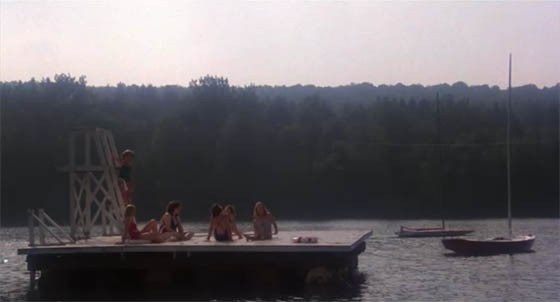 Though Meatballs and The Burning belong to different genres, they’re both “summer camp” films, and so you can’t help but notice the parallels. Both have a centerpiece canoe trip to camp overnight downriver, with the campers plotting to exploit the opportunity for close encounters with the opposite sex. In Meatballs, most everyone scores. In The Burning, a couple of them score, but about half of them are brutally murdered by Cropsy’s giant garden shears. (The two films also entertain the cliché of the camera panning slowly across discarded clothing before arriving at the blissful lovers. But appreciate that The Burning uses the moment to illustrate that first-time sex is sometimes not that blissful, and can be a little disappointing.) Both films feature a spooky tale told by the campfire, though Bill Murray’s tale of a hook-handed killer is not actually ironic foreshadowing of any events which follow. Both hit summer camp touchstones of sports competitions, crowded cafeterias, and gawking lakeside at girls in bikinis. Bill Murray orchestrates elaborate pranks on Morty (Harvey Atkin), the camp leader, in which he and his young charges sneak into Morty’s room late at night, and move the sleeping Morty – and his bed – to various uncomfortable places outdoors, to his chagrin. The Burning‘s prank involves young campers sneaking into the room of camp janitor Cropsy and setting up a worm-covered skull with candles by his bedside, which, when he wakes, causes him to thrash about in terror, knock over the candle, light his entire room on fire, and stumble outside covered in flames. To his chagrin. And subsequent ritualistic slaughter of camping teenagers.
Though Meatballs and The Burning belong to different genres, they’re both “summer camp” films, and so you can’t help but notice the parallels. Both have a centerpiece canoe trip to camp overnight downriver, with the campers plotting to exploit the opportunity for close encounters with the opposite sex. In Meatballs, most everyone scores. In The Burning, a couple of them score, but about half of them are brutally murdered by Cropsy’s giant garden shears. (The two films also entertain the cliché of the camera panning slowly across discarded clothing before arriving at the blissful lovers. But appreciate that The Burning uses the moment to illustrate that first-time sex is sometimes not that blissful, and can be a little disappointing.) Both films feature a spooky tale told by the campfire, though Bill Murray’s tale of a hook-handed killer is not actually ironic foreshadowing of any events which follow. Both hit summer camp touchstones of sports competitions, crowded cafeterias, and gawking lakeside at girls in bikinis. Bill Murray orchestrates elaborate pranks on Morty (Harvey Atkin), the camp leader, in which he and his young charges sneak into Morty’s room late at night, and move the sleeping Morty – and his bed – to various uncomfortable places outdoors, to his chagrin. The Burning‘s prank involves young campers sneaking into the room of camp janitor Cropsy and setting up a worm-covered skull with candles by his bedside, which, when he wakes, causes him to thrash about in terror, knock over the candle, light his entire room on fire, and stumble outside covered in flames. To his chagrin. And subsequent ritualistic slaughter of camping teenagers.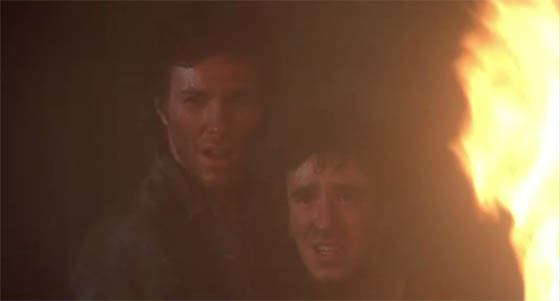 But which plotline is more emotionally rewarding? Bill Murray teaching Rudy self-confidence and pride, so that when the moment comes, the boy can win the track race which allows the camp of misfits to triumph over their snobby neighbors? Or Counsellor Todd bonding with social pariah Alfred as the two of them confront Cropsy in his secret hiding place, where Alfred stabs him through the chest with the killer’s own garden shears, Todd sinks an axe into his head, and they both set fire to him once again just as the police finally arrive? All I’m suggesting is that Bill Murray will probably forget snot-nosed Rudy by next summer, but Alfred and Counsellor Todd will carry their moments together for the rest of their lives. Albeit in a kind of Stephen King’s It kind of way. Still, it’s a bond that holds.
But which plotline is more emotionally rewarding? Bill Murray teaching Rudy self-confidence and pride, so that when the moment comes, the boy can win the track race which allows the camp of misfits to triumph over their snobby neighbors? Or Counsellor Todd bonding with social pariah Alfred as the two of them confront Cropsy in his secret hiding place, where Alfred stabs him through the chest with the killer’s own garden shears, Todd sinks an axe into his head, and they both set fire to him once again just as the police finally arrive? All I’m suggesting is that Bill Murray will probably forget snot-nosed Rudy by next summer, but Alfred and Counsellor Todd will carry their moments together for the rest of their lives. Albeit in a kind of Stephen King’s It kind of way. Still, it’s a bond that holds.




